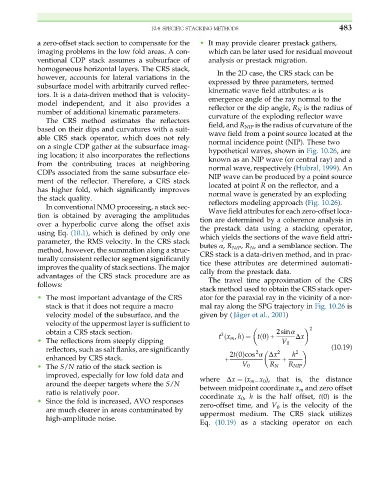Page 492 - Acquisition and Processing of Marine Seismic Data
P. 492
10.4 SPECIFIC STACKING METHODS 483
a zero-offset stack section to compensate for the • It may provide clearer prestack gathers,
imaging problems in the low fold areas. A con- which can be later used for residual moveout
ventional CDP stack assumes a subsurface of analysis or prestack migration.
homogeneous horizontal layers. The CRS stack, In the 2D case, the CRS stack can be
however, accounts for lateral variations in the expressed by three parameters, termed
subsurface model with arbitrarily curved reflec- kinematic wave field attributes: α is
tors. It is a data-driven method that is velocity-
emergence angle of the ray normal to the
model independent, and it also provides a
reflector or the dip angle, R N is the radius of
number of additional kinematic parameters.
curvature of the exploding reflector wave
The CRS method estimates the reflectors
field, and R NIP is the radius of curvature of the
based on their dips and curvatures with a suit-
wave field from a point source located at the
able CRS stack operator, which does not rely
normal incidence point (NIP). These two
on a single CDP gather at the subsurface imag-
hypothetical waves, shown in Fig. 10.26, are
ing location; it also incorporates the reflections
known as an NIP wave (or central ray) and a
from the contributing traces at neighboring
normal wave, respectively (Hubral, 1999). An
CDPs associated from the same subsurface ele-
NIP wave can be produced by a point source
ment of the reflector. Therefore, a CRS stack
located at point R on the reflector, and a
has higher fold, which significantly improves
normal wave is generated by an exploding
the stack quality.
reflectors modeling approach (Fig. 10.26).
In conventional NMO processing, a stack sec-
Wave field attributes for each zero-offset loca-
tion is obtained by averaging the amplitudes
tion are determined by a coherence analysis in
over a hyperbolic curve along the offset axis the prestack data using a stacking operator,
using Eq. (10.1), which is defined by only one which yields the sections of the wave field attri-
parameter, the RMS velocity. In the CRS stack butes α, R NIP , R N , and a semblance section. The
method, however, the summation along a struc- CRS stack is a data-driven method, and in prac-
turally consistent reflector segment significantly tice these attributes are determined automati-
improves the quality of stack sections. The major cally from the prestack data.
advantages of the CRS stack procedure are as The travel time approximation of the CRS
follows:
stack method used to obtain the CRS stack oper-
• The most important advantage of the CRS ator for the paraxial ray in the vicinity of a nor-
stack is that it does not require a macro mal ray along the SPG trajectory in Fig. 10.26 is
velocity model of the subsurface, and the given by ( J€ ager et al., 2001)
velocity of the uppermost layer is sufficient to
2
obtain a CRS stack section. 2 2sinα
t x m , hð Þ ¼ t 0ðÞ + Δx
• The reflections from steeply dipping V 0
reflectors, such as salt flanks, are significantly 2 2 2 (10.19)
2t 0ðÞcos α Δx h
enhanced by CRS stack. + +
• The S/N ratio of the stack section is V 0 R N R NIP
improved, especially for low fold data and where Δx ¼ (x m x 0 ), that is, the distance
around the deeper targets where the S/N between midpoint coordinate x m and zero offset
ratio is relatively poor.
coordinate x 0 , h is the half offset, t(0) is the
• Since the fold is increased, AVO responses
zero-offset time, and V 0 is the velocity of the
are much clearer in areas contaminated by
uppermost medium. The CRS stack utilizes
high-amplitude noise.
Eq. (10.19) as a stacking operator on each

